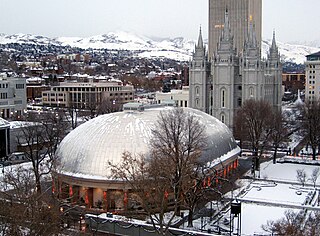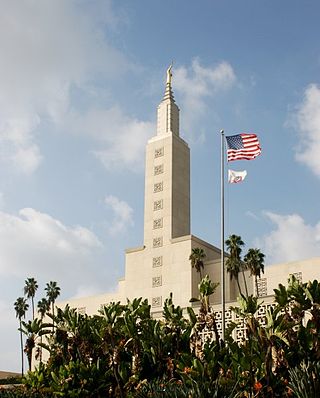
TheTabernacle Choir at Temple Square, formerly known as the Mormon Tabernacle Choir, is an American choir affiliated with the Church of Jesus Christ of Latter-day Saints. It has performed in the Salt Lake Tabernacle for over 100 years. Its weekly devotional program, Music & the Spoken Word, is one of the longest-running radio programs in the world, having aired every week since July 15, 1929.

Temple Square is a 10-acre (4.0 ha) complex, owned by the Church of Jesus Christ of Latter-day Saints, in the center of Salt Lake City, Utah. The usage of the name has gradually changed to include several other church facilities that are immediately adjacent to Temple Square. Contained within Temple Square are the Salt Lake Temple, Salt Lake Tabernacle, Salt Lake Assembly Hall, the Seagull Monument, and two visitors' centers. The square was designated a National Historic Landmark District in 1964, recognizing the Mormon achievement in the settlement of Utah.

Salt Lake City, Utah has many historic and notable sites within its immediate borders. Although the entire Salt Lake City metropolitan area is often referred to as "Salt Lake City", this article is concerned only with the buildings and sites within the official city limits of Salt Lake City.

The Conference Center, in Salt Lake City, Utah, is the premier meeting hall for the Church of Jesus Christ of Latter-day Saints. Completed in 2000, the 21,000-seat Conference Center replaced the traditional use of the nearby Salt Lake Tabernacle, built in 1868, for the church's biannual general conference and other major gatherings, devotionals, and events.

The Salt Lake Tabernacle, formerly known as the Mormon Tabernacle, is located on Temple Square in Salt Lake City, in the U.S. state of Utah. The Tabernacle was built from 1863 to 1875 to house meetings for the Church of Jesus Christ of Latter-day Saints. It was the location of the church's semi-annual general conference until the meeting was moved to the new and larger LDS Conference Center in 2000. Now a historic building on Temple Square, the Salt Lake Tabernacle is still used for overflow crowds during general conference. It is renowned for its remarkable acoustics and iconic pipe organ. The Tabernacle Choir has performed there for over 100 years.

The Orchestra at Temple Square (Orchestra) is a 110-member orchestra based in Salt Lake City, Utah. The Orchestra was created in 1999 under the direction of Gordon B. Hinckley, then the president of the Church of Jesus Christ of Latter-day Saints, as part of an initiative to continually strengthen and expand the capabilities of the church's music organizations.

Music & the Spoken Word is a religious radio and television series. Broadcast weekly from the Salt Lake Tabernacle in Salt Lake City, Utah, the program primarily features performances of music by Tabernacle Choir (Choir)—often accompanied by the Salt Lake Tabernacle organ and the Orchestra at Temple Square. The program also includes spiritual messages and passages related to a specific episode's theme, presented by Derrick Porter.

The Church Office Building is a 28-story building in Salt Lake City, Utah, which houses the administrative support staff for the lay ministry of the Church of Jesus Christ of Latter-day Saints throughout the world.

The Los Angeles California Temple, the tenth operating and the second-largest temple operated by the Church of Jesus Christ of Latter-day Saints, is on Santa Monica Boulevard in the Westwood district of Los Angeles, California, United States.

Alexander Ferdinand Schreiner was one of the most noted organists of the Salt Lake Tabernacle. He also wrote the music to several LDS hymns, several of which are in the current edition of the hymn book of the Church of Jesus Christ of Latter-day Saints.
The Mormon Youth Symphony and Chorus (MYSC) was an official musical organization of the Church of Jesus Christ of Latter-day Saints from 1969 to 1999, composed of young musicians aged 18 to 33. In its 30-year history, MYSC was credited with many television specials, numerous recordings, concerts, and several major tours throughout the United States. The group was disbanded during the 1999 reorganization of the Tabernacle Choir and resulting creation of the Orchestra at Temple Square. The choral arm of the group provided music for the church's annual and semi-annual general conferences, usually during the Saturday morning sessions.

The Bells at Temple Square is a handbell choir that is an official music organization of the Church of Jesus Christ of Latter-day Saints. It was formed in 2005 under the direction of the Mormon Tabernacle Choir (Choir). The group is a double handbell choir, performing with 27 to 35 ringers on two sets of Malmark handbells and two sets of Malmark handchimes. The octave two bells are Malmark aluminums. Each part is usually doubled, except octave two.

The Schoenstein Organ at the Conference Center is a pipe organ built by Schoenstein & Co., San Francisco, California located in the Conference Center of the Church of Jesus Christ of Latter-day Saints in Salt Lake City, Utah. The organ was completed in 2003. It is composed of 160 speaking stops spread over five manuals and pedals. Along with the nearby Salt Lake Tabernacle organ, it is typically used to accompany the Tabernacle Choir at Temple Square. Schoenstein & Co.'s president and tonal director, Jack Bethards, describes it as "an American Romantic organ" that is "probably more English than anything else."

In the Church of Jesus Christ of Latter-day Saints, a tabernacle is a multipurpose religious building, used for church services and conferences, and as community centers. Tabernacles were typically built as endeavors of multiple congregations, usually at the stake level. They differ from meetinghouses in scale and differ from temples in purpose.

The Provo City Center Temple is a temple of the Church of Jesus Christ of Latter-day Saints, built on the site of the former Provo Tabernacle in Provo, Utah. Completed in 2016, the temple uses much of the external shell of the tabernacle that remained from the original building after a fire in December 2010. The intent to build the temple was announced on October 1, 2011, by church president Thomas S. Monson, during the church's general conference. The temple is the second in Provo, was the sixteenth in Utah, and the church's 150th worldwide. This temple has a distinctive exterior with Gothic-inspired stained glass windows. A groundbreaking ceremony, to signify the beginning of construction, was held on May 12, 2012, conducted by Jeffrey R. Holland.

Rejoice and Be Merry!: Christmas with the Mormon Tabernacle Choir and Orchestra at Temple Square featuring The King's Singers was recorded during the Mormon Tabernacle Choir's 2007 Christmas shows in the LDS Conference Center with special guests The King's Singers. The album was released on September 30, 2008 and a concert DVD was released on October 21, 2008.

The following outline is provided as an overview of and a topical guide to the Church of Jesus Christ of Latter-day Saints.

The Mormon Trail Center at Winter Quarters is a museum and visitors' center of the Church of Jesus Christ of Latter-day Saints located in the Florence neighborhood of Omaha, Nebraska, United States. The museum interprets the story of the Mormon Trail along with the history of a temporary Mormon settlement known as Winter Quarters, which was located in the Florence area between 1846–1848.
A visitors' center is a building often near a temple of the Church of Jesus Christ of Latter-day Saints where missionaries teach visitors about the tenets of their faith and other community events are held. Visitors' centers often include a replica of Bertel Thorvaldsen's Christus statue, exhibits, musical performances, devotionals, and a Family History Center (FHC).


















